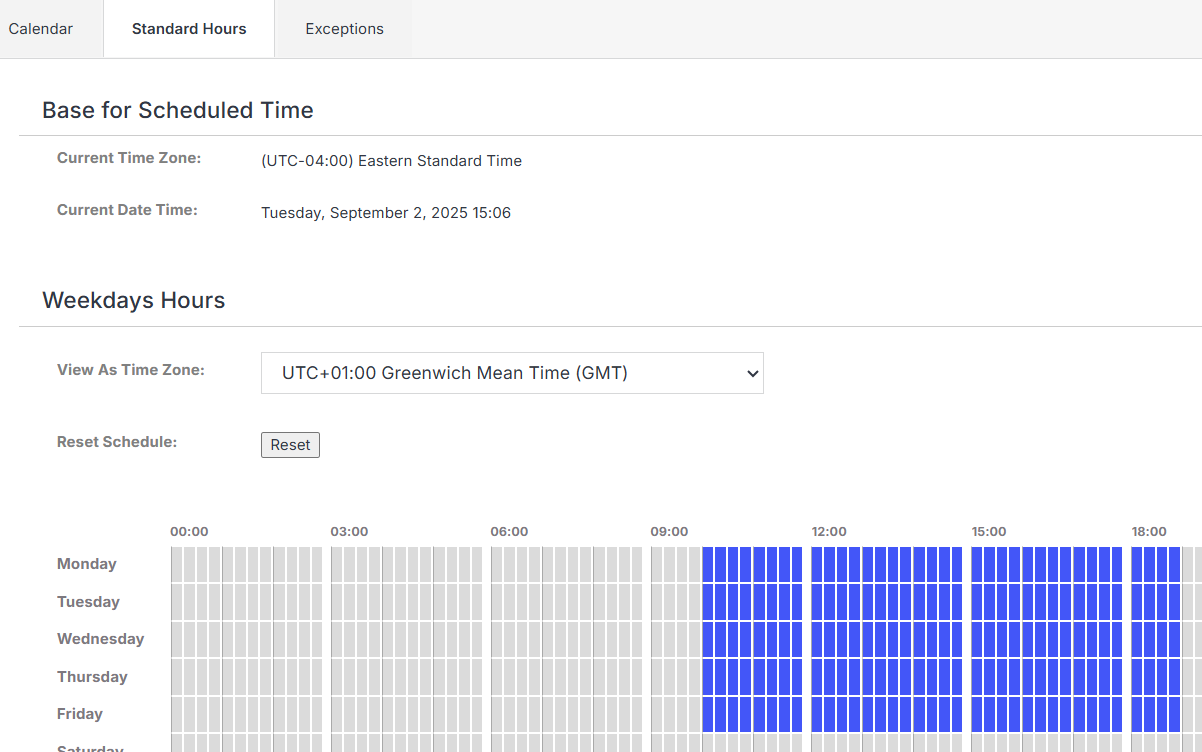Calendars
You can set up calendars for each region to define business hours. The business hours are primarily used for reporting to calculate the amount of business time spent on a case or other units.
Define Calendar
To create a new calendar:
In Administration, select System Setup > Reporting Configuration > Calendars.
Click New Calendar.
In the New Calendar dialog box, type an ID for the new Calendar.
Click OK.
Once the Calendar ID is created, you are redirected to the Calendar tab, where you can complete the calendar setup by providing a Description and Notes for the calendar.
Standard Hours
Base for Scheduled Time
The Standard Hours tab allows you to define the schedule for standard business hours by time and day of the week for different time zones.
Field | Description |
|---|---|
Current Time Zone | This is the time zone defined in the Agent User Profile. If the Agent User time zone is not specified, it defaults to the System time zone. This time zone serves as the base time zone for setting up scheduled times, unless another time zone is specified in the “View As Time Zone” dropdown menu. |
Current Date Time | This is the current date and time in the specified time zone. |
Weekdays Hours
To set up Standard Hours, select the time zone for which you want the hours to be set from the View As Time Zone dropdown menu. Then, highlight the time slots by clicking and holding the mouse on the slot, dragging it over the desired time, and releasing the button. You can set multiple working periods throughout the day. Click Save to confirm.
Once the standard hours are set, you can view what the schedule looks like in different time zones by selecting a time zone from the View As Time Zone dropdown menu, modify them, or completely reset them by clicking the Reset button.
Exceptions
The Exceptions tab allows you to define exceptions for the given calendar by setting up a different schedule for a specific day or marking it as “off.” Exceptions will be considered in reporting to correctly calculate business time.
Once an exception is added for a given day, the standard hours for that day will not apply. So, for example, if the expectation is that the business will work in the morning as usual but take the afternoon off, you would add the exception for the hours worked in the morning (not the hours that the business will be off in the afternoon.) In this example, the exception would be that on a given date you work 8 am to noon and “Is Off” would not be checked.
However, if the exception is that the business is taking the whole day off for a holiday, then ensure to check the Is Off checkbox.
To create a new exception for a specific time zone, select the time zone from the View As Time Zone dropdown menu first:
Click the New Exception button.
In the New Exception dialog box, specify the input parameters.
Click Add.
Field | Description |
|---|---|
Date | The date of the exception. |
Start Time | The new start time for the given exception date. |
End Time | The new end time for the given exception date. |
Time Zone | The time zone for which you want the exception to be set. The time zone selected in the “View As Time Zone” dropdown menu. |
Is Off | Mark the exception date as “off” to exclude it from the schedule. |
Description | Add a description for the exception if needed. |
Once the exceptions are set, you can view what the exception's date and time look like in different time zones by selecting a time zone from the “View As Time Zone” dropdown menu. To modify the exception, click on the exception date. You can filter the exceptions list by year using the dropdown menu.
Daylight Saving Time
In 13.0, business hours now properly handles Daylight Saving Time (DST).
DST in Configuration
When selecting View as Time Zone, the dropdown now shows the correct UTC offset for the moment when you view the calendar.
Example:
Eastern Standard Time (EST) → UTC-05:00 (Nov–Mar)
Eastern Standard Time (EST) → UTC-04:00 (Mar–Nov)
The offset changes automatically at the actual DST transition time for each region.
Current Time Zone behaves the same way. DST is applied.
Business hours you set up (e.g., 8 AM - 6 PM) remain the same year-round. They do not shift with DST.
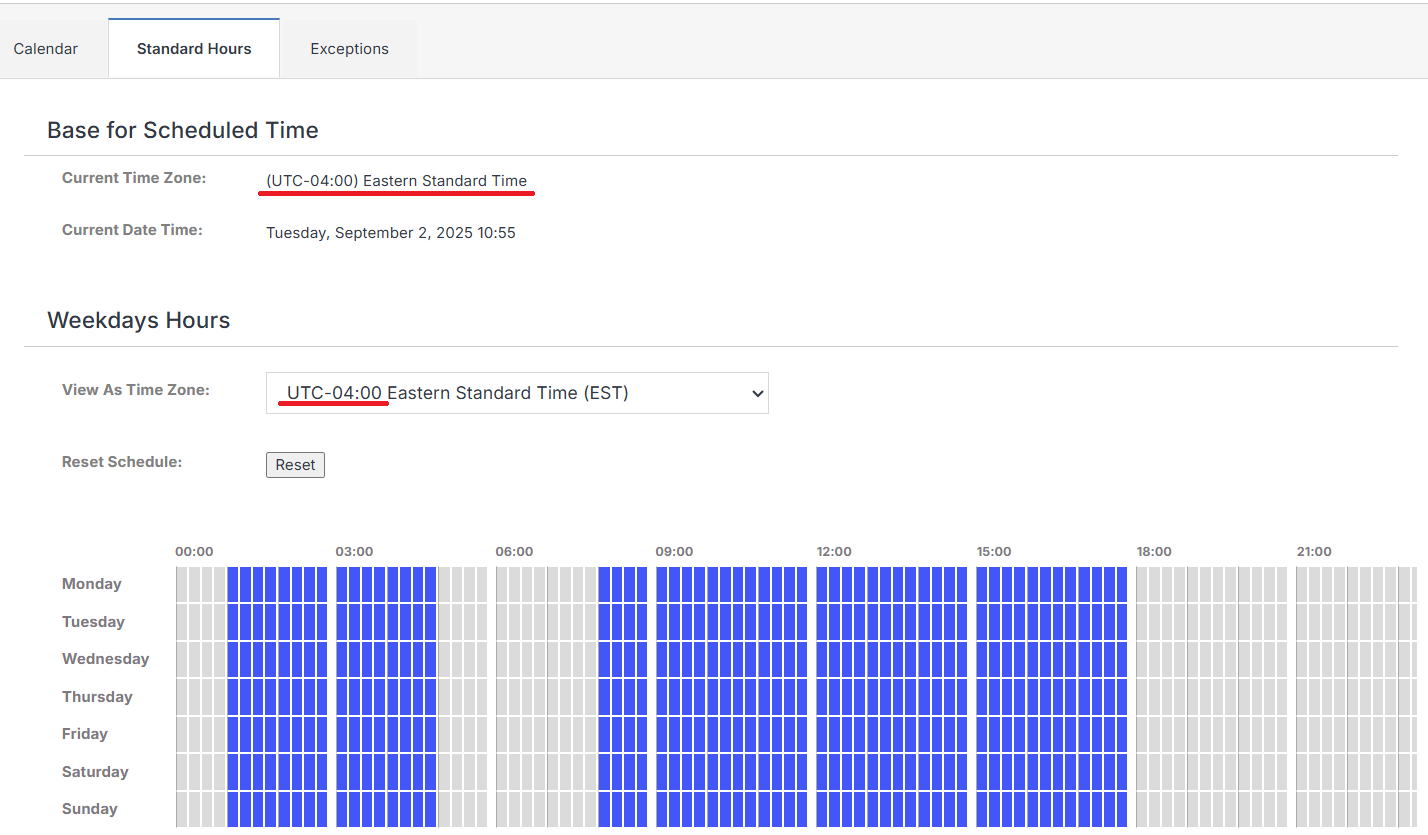
Every time zone in the dropdown shows the offset adjusted for the current date.
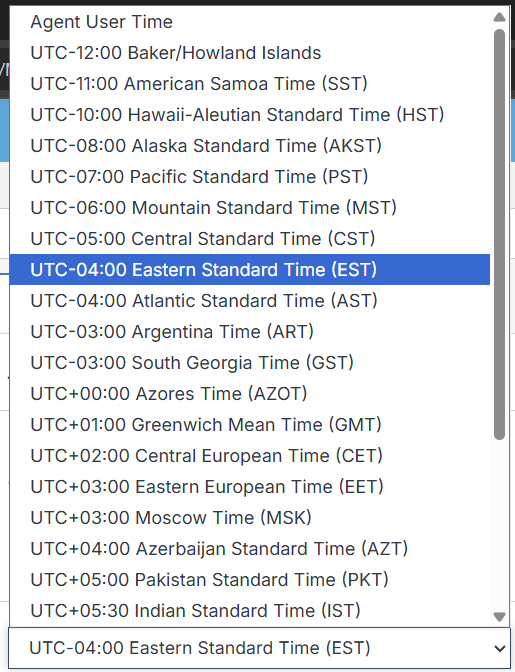
Example:
On March 14 2025, I create a 9 AM – 6 PM calendar in London time (UTC+00:00, Greenwich Mean Time).
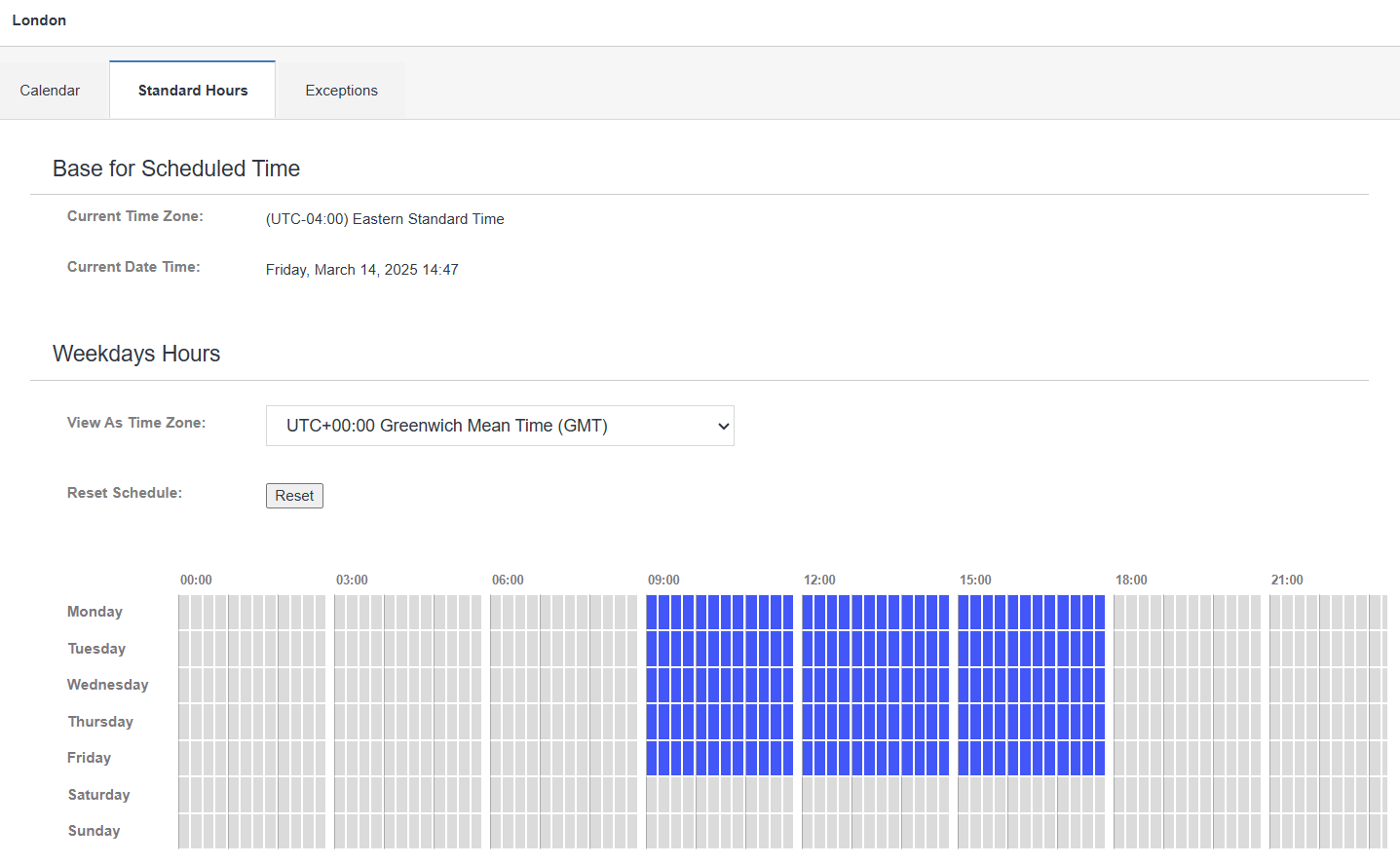
After saving the hours, I switch View As Timezone to Ohio time (UTC−04:00, Eastern Time). It shows 5 AM – 2 PM.
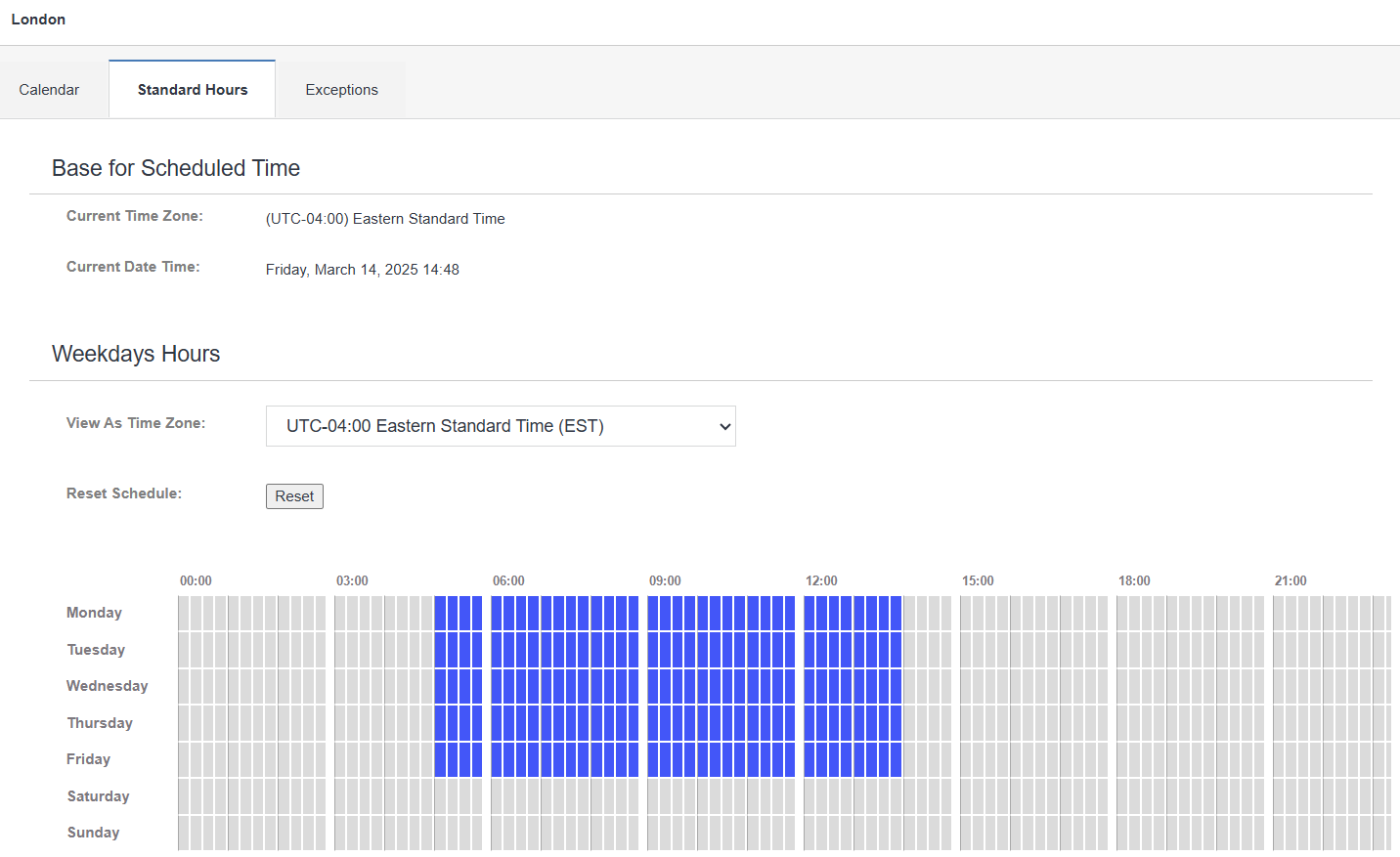
At this point, London has not yet started Daylight Saving Time (still UTC+00:00).
Ohio already started DST on March 9, 2025, shifting from UTC−05:00 to UTC−04:00.
Result: there’s a 4-hour difference between London and Ohio until London switches to DST on March 30, 2025.
Business hours remain fixed at 9 AM – 6 PM in System Time Zone (Eastern Time with DST). They do not shift when London enters DST. However, when viewed as London time, they appear as 10 AM – 7 PM because the offset relative to the system time zone has changed.
When DST Affects Results
Business hours calculation accounts for DST to prevent off-by-one-hour errors in reports. DST only impacts results if the defined business hours overlap the the DST transition time (2 AM for EST). Business hours like 8 AM - 6 PM are never affected by DST since they don't cross the 2 AM transition time.
For example:
Business hours 1 AM - 5 AM daily. Case received at 1 AM, closed at 3 AM on Spring Forward day (March 9, 2025 ) → Returns 1 hour instead of 2, because we lost 1 hour due to DST
Business hours 1 AM - 5 AM daily. Case received at 1 AM, closed at 3 AM on Fall Back day (November 2, 2025) → Returns 3 hours instead of 2, because we gained 1 hour due to DST
Business hours 8 AM - 6 PM daily. Case received at 1 AM, closed at 10 AM on Spring Forward day (March 9, 2025) → Returns 2 hours, not affected by DST.
Report on Business Hours
Make sure a calendar is configured
Set up a special report column
Administration > System Setup > System Metadata > System Paragraph Inserts > Special Report Columns
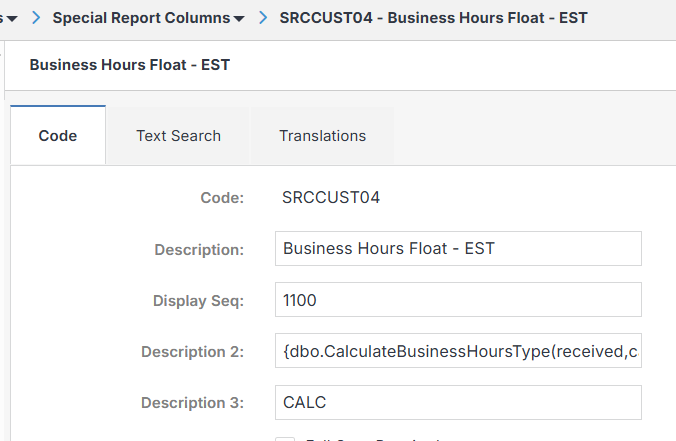
Examples
Description 2: {dbo.CalculateBusinessHoursType(received,case_id.closed,'USA','float')};case_id
Calculates the business hours between case received and case closed date time, with the hours specified in calendar USA, and returns a float number.
{dbo.CalculateBusinessHoursType(received,case_id.closed,'USA','time')};case_id
Same as the previous example, except it returns a hh:mm string.
Description 3 must be CALC
If a customer doesn’t have a system time zone set up, use dbo.CalculateBusinessHoursType_UseTZ and provide the system time zone (so daylight savings can be accounted for).
Example:
{dbo.CalculateBusinessHoursType_UseTZ(received,case_id.closed,'USA','float','Eastern Standard Time')};case_id
To verify a system_timezone value, run:SELECT name FROM sys.time_zone_info WHERE name = '<your_timezone_here>';
If no rows are returned, the value is not valid.
Add the special report column as a report column
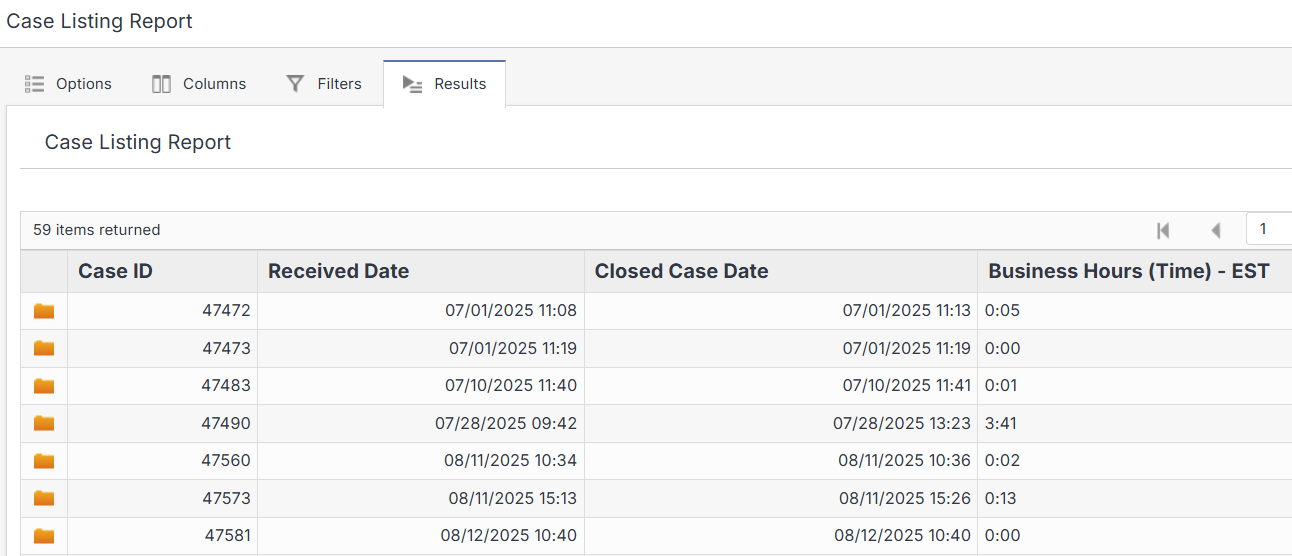
Time format
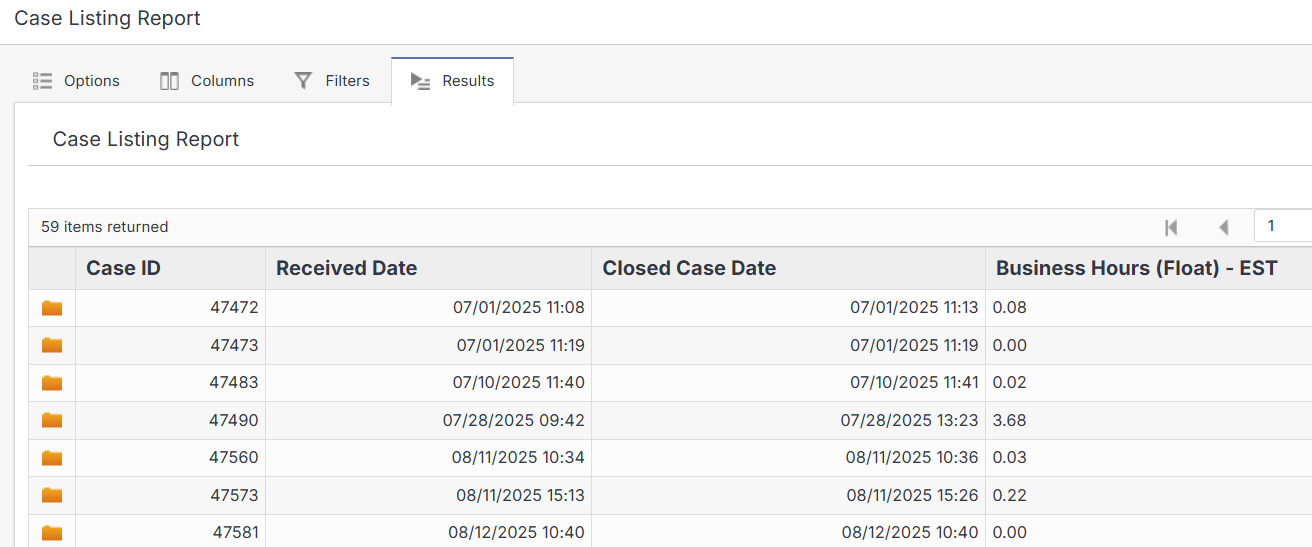

Float number
Decimal format defines how numbers are displayed. It can be configured at Administration > System Setup > System Parameters > Miscellaneous.

For example, in #,##0.00, the comma adds a thousands separator (1234.56 → 1,234.56), the 0 ensures at least one digit is shown (so 0.5 → 0.50 instead of .50), and .00 enforces two decimal places.

